

12 Animals You've Never Heard Of. BIG CATS like boxes too! The happiest animal in the world. ×Imgur needs your help to win the Webby Award for best social entertainment site!
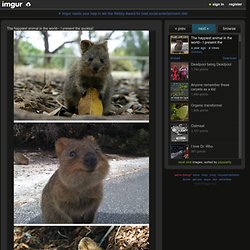
Browse your computer drag and drop here Ctrl + V paste from your clipboard By uploading, you agree to our terms of service That file type is not supported! And aliens should be weird, right? Never give up! Some weird animals... Kookaburra calls-Cincinnati Zoo. Capybara. Das Capybara oder Wasserschwein ( Hydrochoerus hydrochaeris ) ist eine Säugetierart und das größte lebende Nagetier der Erde.

Es bewohnt feuchte Regionen in Südamerika und zeigt im Körperbau und in seiner semiaquatischen (teilweise im Wasser stattfindenden) Lebensweise gewisse Ähnlichkeiten mit den Flusspferden , ist jedoch eng mit den Meerschweinchen verwandt. Merkmale [ Bearbeiten ] Capybaras halten sich vorwiegend im Wasser auf, die Schwimmhäute zwischen ihren Zehen helfen ihnen dabei, sich schnell zu bewegen. Ohren, Augen und Nase verlaufen in einer Linie, ähnlich wie beim Kaiman.
So müssen sie beim Schwimmen nicht komplett den Kopf herausstrecken und sind für ihre zahlreichen Feinde kaum zu erspähen. Körperbau und Fell [ Bearbeiten ] Der Körper der Capybaras ist massiv und plump gebaut, einem stämmigen Rumpf stehen kurze Gliedmaßen gegenüber. Schuppentiere. Die Schuppentiere oder Tannenzapfentiere (Manidae) sind eine Säugetierfamilie .

Sie gehören vermutlich zur Verwandtschaft der Raubtiere , werden aber in eine eigene Ordnung , Pholidota, gestellt. Einzigartig unter den Säugetieren ist die Körperbedeckung mit großen, überlappenden Hornschuppen. Es sind insektenfressende Tiere, die durch Grabkrallen und eine lange Zunge an diese Ernährungsweise angepasst sind. Im Bedrohungsfall können sie sich zu einer Kugel einrollen. Schuppentiere leben je nach Art am Boden oder auf Bäumen, meist sind sie nachtaktiv. Sloth. Sloths make a good habitat for other organisms, and a single sloth may be home to moths, beetles, cockroaches, ciliates, fungi, and algae.[2] Taxonomy and names Ecology.

Tarsier. Kiwi. The kiwi is a national symbol of New Zealand, and the association is so strong that the term Kiwi is used in some parts of the world as the colloquial demonym for New Zealanders.

Etymology[edit] The Māori language word kiwi (/ˈkiːwiː/ KEE-wee)[4] is generally accepted to be "of imitative origin" from the call.[5] However, some linguists derive the word from Proto-Nuclear Polynesian *kiwi, which refers to Numenius tahitiensis, the Bristle-thighed Curlew, a migratory bird that winters in the tropical Pacific islands.[6] With its long decurved bill and brown body, the curlew resembles the kiwi. So when the first Polynesian settlers arrived, they may have applied the word kiwi to the new-found bird.[7] The genus name Apteryx is derived from Ancient Greek "without wing": a-, "without" or "not"; pterux, "wing".[8] Taxonomy and systematics[edit]
Tapir. A tapir (/ˈteɪpər/ TAY-pər or /təˈpɪər/ tə-PEER) is a large herbivorous mammal, similar in shape to a pig, with a short, prehensile snout.
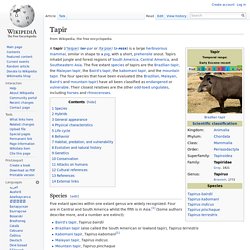
Tapirs inhabit jungle and forest regions of South America, Central America, and Southeastern Asia. The five extant species of tapirs are the Brazilian tapir, the Malayan tapir, the Baird's tapir, the kabomani tapir, and the mountain tapir. The four species that have been evaluated (the Brazilian, Malayan, Baird's and mountain tapir) have all been classified as endangered or vulnerable.
Their closest relatives are the other odd-toed ungulates, including horses and rhinoceroses. Species[edit] Five extant species within one extant genus are widely recognized. Echidna. Echidnas ( pron.: / ɨ ˈ k ɪ d n ə / ), sometimes known as spiny anteaters , [ 1 ] belong to the family Tachyglossidae in the monotreme order of egg -laying mammals .
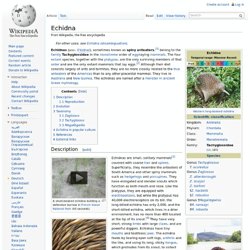
The four extant species, together with the platypus , are the only surviving members of that order and are the only extant mammals that lay eggs. [ 2 ] Although their diet consists largely of ants and termites, they are no more closely related to the true anteaters of the Americas than to any other placental mammal. They live in Australia and New Guinea . The echidnas are named after a monster in ancient Greek mythology . Platypus. Until the early 20th century, it was hunted for its fur, but it is now protected throughout its range.
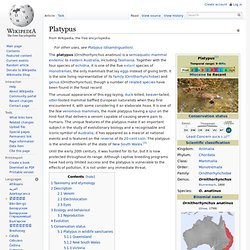
Although captive breeding programs have had only limited success and the platypus is vulnerable to the effects of pollution, it is not under any immediate threat. Taxonomy and etymology There is no universally agreed plural of "platypus" in the English language. Scientists generally use "platypuses" or simply "platypus".
Quokka. The quokka (/ˈkwɒkə/, Setonix brachyurus), the only member of the genus Setonix, is a small macropod about the size of a domestic cat.[2] Like other marsupials in the macropod family (such as the kangaroos and wallabies), the quokka is herbivorous and mainly nocturnal.

It can be found on some smaller islands off the coast of Western Australia, in particular on Rottnest Island just off Perth and Bald Island near Albany. A small mainland colony exists in the protected area of Two Peoples Bay Nature Reserve, where they co-exist with Gilbert's potoroo. Discovery by Europeans[edit] Liger. The liger is a hybrid cross between a male lion ( Panthera leo ) and a tigress ( Panthera tigris ).
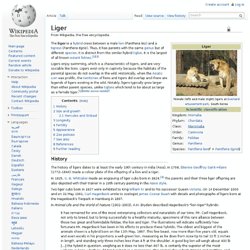
Thus, it has parents with the same genus but of different species . It is distinct from the similar hybrid tiglon . It is the largest of all known extant felines . [ 1 ] [ 2 ] Ligers enjoy swimming, which is a characteristic of tigers, and are very sociable like lions. Asiatische Riesenhornisse. Asiatische Riesenhornisse Die Asiatische Riesenhornisse ( Vespa mandarinia Smith, 1852) ist eine in Ost- und Südostasien vorkommende Hornissenart . Asiatische Riesenhornissen sind bis zu fünfmal größer als Westliche Honigbienen . Ein Stich der Riesenhornisse wird als äußerst schmerzhaft beschrieben. In Japan , wo diese Insekten Ōsuzumebachi ( オオスズメバチ ; zu dt. „Spatzbiene“) genannt werden, sterben im Jahr durchschnittlich 40 Menschen durch eine allergische Reaktion auf ihre Stiche. Merkmale [ Bearbeiten ]